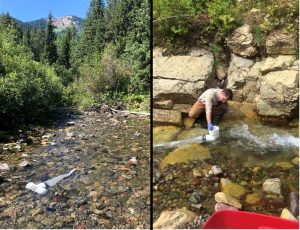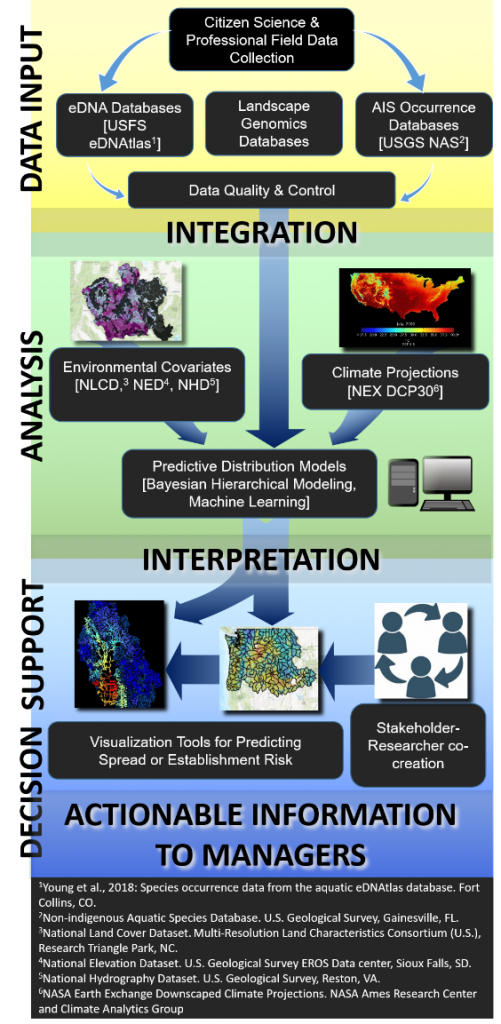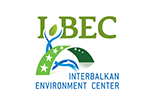Predictive Tracking of Aquatic Invasive Species Nation-Wide

The main objective of the project entitled “Predicting the Spread of Aquatic Invasive Species Using Remote Sensing, Genetics, and Climate Modeling” is to predict the presence and spread of a multitude of aquatic invasive species (AIS) that are currently invading US waterways, and disrupting natural ecosystems on which native, sometimes endangered species depend. This effort supports water conservation managers as well as fishery managers and fish and wildlife conservation efforts with monitoring and reporting for Sustainable Development Goal (SDG) target 15.8, “introduce measures to prevent the introduction and significantly reduce the impact of invasive alien species on land and water ecosystems, and control or eradicate the priority species.”
This initiative implements data with the help of environmental DNA (eDNA) collection. This method uses in-situ water sample collections, as a means of monitoring to detect the presence or absence of a target species. DNA is always present in an aquatic environment, even if in trace amounts, and this method of water collection is generally more efficient and less expensive than traditional observational methods, and sensitive enough to detect hard-to-find species. The team’s goal is to compile all AIS observational data into one national database for the development of predictive modeling that will include key environmental variables that will contribute to the identification of new predicted AIS “hotspots”.
Earth Observation Data Sources
Remotely-sensed environmental co-variates stemming in part from a previous project (Riverscape Analysis Project (RAP)) will be integrated into the creation of predictive modeling for AIS “hotspots”. RAP was focused on the collection of environmental data as a decision support system (DSS) for the conservation of native salmonids. Data from NASA sensors, MODIS AQUA, MODIS TERRA, and LANDSAT 5, 7, and 8 were also used to derive products necessary for this project’s work.
Other Data Sources
Historical and real-time gathered AIS data produced either through direct observation in the field or eDNA water sample collection.
Progress
This project launched in October 2019 after the final hiring of a postdoctoral researcher (Dr. Charles van Rees) to help coordinate the team’s efforts. In order to test the workflow developed, a pilot project has been kicked off for the tracking of brook trout, an AIS that has been known to degrade natural ecosystems and hurt populations of native species, Bull trout. Brook trout occurrence data has been collected from many agencies in the form of observational or eDNA data. These agencies include organizations like the United States Geological Survey (USGS), the United States Forestry Service (USFS), Montana Fish, Wildlife and Parks (MT FWP), and the National Parks Service. Luikart, Kimball, Hand and their team are working with these agencies to integrate their AIS data into a national database that can be viewed by all and for streamlined amalgamation into the predictive AIS projections.
The NASA-funded team has also started a collaboration with Dr. Wes Daniel and Dr. Matt Neilson of the USGS to connect local invasive species managers with their growing, centralized national database of aquatic invasive species data, the Nonindigenous Aquatic Species (NAS) database. Luikart’s team has helped several key agencies in Montana contribute their AIS data to NAS and is now working with USGS to select NASA products and other remote sensing data to make available to support managers in their use of NAS. Ultimately, they hope to provide quick tools for estimating relative spread risk of invasive species across scales so managers can make smarter decisions about how to prevent and contain the spread of harmful aquatic invasive species.
The team is also currently developing manuscripts concerning methodologies and results that they have found extremely helpful in the advancement of this project’s goals. These papers surround topics such as:
– The workflow created to show that remote sensing products and eDNA data can be used to effectively track AIS
-How to effectively navigate the ambiguity that can come along with eDNA data, and how to integrate that data when observed by a manager in their water catchment
-Best practices for mobile apps that will use the AIS data collected, including necessary key features
Outreach and Communications
The Luikart group has conversed with major conservation and water management agencies about the necessity of their work, and have been met with enthusiastic responses from these stakeholders (USGS, USFS, MT FWP, US Fish and Wildlife Service). They have also shared their ideas on data integration and the necessity of collaboration between agencies at the Western Regional Panel on AIS, NISC (National Invasive Species Council), and the National eDNA Technical Meeting. The team has recently presented their work to the Group on Earth Observations Biodiversity Observation Network (GEO BON) to discuss how their predictive workflow could guide invasive species research and management at the global scale.

Challenges
Compiling, organizing, and processing all of the collected data is a complicated task, and one that has been historically difficult to find project staff to complete it. Working with so many persons nation-wide, it has also been challenging to create meeting dates that work well with all schedules. There have also been some waterway managers who need more education and assurance on the efficiency and accuracy of eDNA practices for AIS detection.
Next Steps
After the development and implementation of the pilot project workflow on brook trout, the team looks forward to new data on rainbow trout and smallmouth bass, and to publish a manuscript on this pilot project. Their findings and results are being communicated to managers, biologists, and their project stakeholders nationwide to help gain more ground and interest in preventing AIS spread. In the coming year, they are developing the prototype of their AIS tools for the support of the NAS database and the collation of these data for use in AIS visualization and mapping tools.
Supporting Materials
Sepulveda, A., N. Nelson, C. Jerde, and G. Luikart. 2020. Environmental DNA methods work, but are they ready for invasive species management? Trends in Ecology and Evolution, 35:641-744.
Publications
Are Environmental DNA Methods Ready For Aquatic Invasive Species Management?
Project Funding and Implementation
This project is funded by NASA’s Applied Sciences Program. Implementation is being led by the University of Montana, USGS, USFS, MT-FWP.
Project Principal Investigator
Dr. Gordon Luikart
Co-Investigators
Dr. Clint Muhlfield, Dr. Adam Sepulveda, Dr. John S. Kimball, Dr. Brian Hand, Dr. Cody Youngbull
Partner/End User Organization Representatives and Collaborators
USGS
Dr. Matthew Neilson, Dr. Jon Amberg , Dr. Wes Daniel
MT FWP
Dr. Andrew Whiteley, Matt Boyer, Dr. Ryan Kovach
Washington Dept. Fish & Wildlife
Jesse Schultz
US Forest Service
Beth Gardner
Confederated Salish & Kootenai Tribes
Craig Barfoot
View All Projects


























